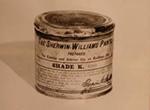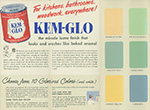Amanda Lecky
You can learn a lot about the influence paint technology has had on color trends by tracing the 150-year history of Sherwin-Williams innovation.
Popular paint colors come and go — and, sometimes, come again. Take gray, for example. Jazz Age designers loved silver in the streamlined 1920s; blue-based shades paired just perfectly with mauve in the sleek 1980s; and of course pewter and greige are popular today. But none of these rising and fading color fortunes would be possible without the introduction in 1880 of Sherwin-Williams “Painter’s Prepared,” the first successful ready-mixed paint sold with a guarantee.
“That invention was a huge change for home color,” says Jackie Jordan, Director of Color Marketing at Sherwin-Williams. “Before that, painters had to mix each batch of paint by hand, resulting in inconsistent and unstable formulas and colorations.” Accordingly, most homes ended up with one of a very limited number of muted, earthy colors, and homeowners had to trust their color choices to the skill of their local painter.

The first can of Sherwin-Williams Paint, Prepared (SWP) made in 1880 and opened in 1916.
Fast-forward to the middle of the 20th century, and residential color had entered a whole new era. “The introduction of latex formulations and tints in 1950 was a second leap forward,”Jordan says. “Oil-based formulas produced muddy colors; with the introduction of latex, we could tint colors much more cleanly and brightly.” Perhaps not surprisingly, the most popular paint colors began to shift away from quiet earth tones to the cheery pastels of the Atomic Age (think Cadillac’s iconic pink and the blue homes in cookie-cutter suburbs). And that was just the beginning: From the mid-century on, paint color options exploded, not always trending toward bold and bright — Jordan notes the subdued golds and browns of the 1970s and the boring beiges of the 1980s — but undeniably toward variety.
Again, technology led the way. “The introduction of in-store color-matching capability opened things up tremendously,” Jordan says. From the debut of the first Sherwin-Williams Kem Colormeter in-store mixing system in 1959 to today’s high-tech ColorSnap® Precision, color matching made it possible for designers and consumers to achieve virtually any color imaginable using their favorite Sherwin-Williams paint. “We can even custom color match to materials such as fabrics,” Jordan says.

Original Kem-Glo Colors.
If you’re working on a historic renovation, it’s simple to replicate the original paint color using in-store matching technology. Or, if you know the original Sherwin-Williams paint color — even if it’s a “retired” shade from a years-old collection — your local store or your Designer Account Executive can help you access the extensive Sherwin-Williams archives.
The archiving process takes place in Sherwin-Williams’ Breen Technical Center, which houses over 350 chemists, scientists and engineers working on the development of new coatings technologies — and keeping careful records of every color produced.
“When a new color has been approved by the Sherwin-Williams designers, physical standards (actual paint samples) and electronic standards (digital analysis of the color) are created. All physical standards are stored in a freezer to minimize change over time and they are compared to the electronic standard of that color before use to ensure no drift has occurred. Currently we have over 35,000 color standards available in our freezer, dating back several decades,” says Dave Kuehner, Director of Research & Development Services at Sherwin-Williams Breen Technical Center.
Of course, shaping the future of color is just as important as preserving and re-creating the past. And as homeowners influenced by the popularity of TV-makeover shows grow more confident and experimental with color, Sherwin-Williams works hard to provide design professionals with the tools they need to anticipate and navigate trends. For example, ColorSnap® is a new, integrated color selection and delivery system that’s designed to work the way designers work — in-office, on-site, online and in-store. Explore, find and specify colors quickly and seamlessly from anywhere.
In addition, Jackie Jordan and her team of color experts present their annual color forecast to more than 10,000 designers each year. “We see the colors in our forecast palettes come to market every time,” she says. “So it’s really a great way for designers to get a jump on what their clients will be asking for next.” That might be gray, again, like the warm shades in the Sherwin-Williams 2016 Pura Vida palette, or a saturated berry or gold from the Más Amor Por Favor group, or a cool plum from the Trajectory collection. “Of course, color is very subjective, so at the end of the day, the trends may not speak to you — it’s all about the colors you love and enjoy,”Jordan says. “And you can match any one in Sherwin-Williams paint.”








